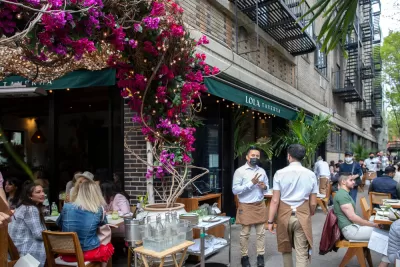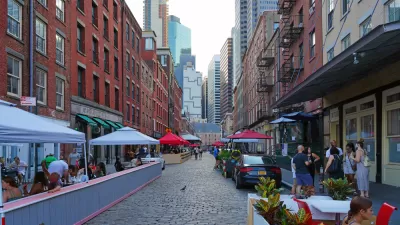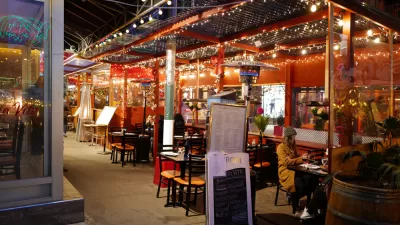Started as a response to pandemic restrictions, al fresco dining has taken off as customers, restaurant owners, and city officials realize the social and economic benefits of outdoor dining spaces.

In a paywalled article in the Boston Globe, Yvonne Abraham describes the persistent popularity of the outdoor dining programs that proliferated during the pandemic. As Abraham points out, “The trend is evolving well beyond the stopgap measures of construction barriers and plastic cones. Five-star hotels and Michelin-starred restaurants are transforming it from shabby to chic.”
And the form is evolving: “It’s taking the form of pop-ups, picnics, cocktail gardens, and poolside dining. Gourmet cuisine is being offered up in caves, heated yurts, and converted ski gondolas, and on tables in the shallows of the ocean.” Restaurants are making creative use of nearby spaces to create entirely unique experiences and an added draw for tourists.
According to the National Restaurant Association, forty percent of consumers say they’re more likely to choose a restaurant with outdoor seating. Many restaurants that began with temporary seating installations that were broken down at the end of the night are shifting to more permanent designs. Even as fears of COVID-19 subside, customers seem to enjoy the diversity of options offered by al fresco dining, and cities have started to extend programs slated for termination and relax rules related to outdoor dining facilities.
FULL STORY: Pull up a chair: Outdoor dining isn't going anywhere

Trump Administration Could Effectively End Housing Voucher Program
Federal officials are eyeing major cuts to the Section 8 program that helps millions of low-income households pay rent.

Planetizen Federal Action Tracker
A weekly monitor of how Trump’s orders and actions are impacting planners and planning in America.

Ken Jennings Launches Transit Web Series
The Jeopardy champ wants you to ride public transit.

Crime Continues to Drop on Philly, San Francisco Transit Systems
SEPTA and BART both saw significant declines in violent crime in the first quarter of 2025.

How South LA Green Spaces Power Community Health and Hope
Green spaces like South L.A. Wetlands Park are helping South Los Angeles residents promote healthy lifestyles, build community, and advocate for improvements that reflect local needs in historically underserved neighborhoods.

Sacramento Plans ‘Quick-Build’ Road Safety Projects
The city wants to accelerate small-scale safety improvements that use low-cost equipment to make an impact at dangerous intersections.
Urban Design for Planners 1: Software Tools
This six-course series explores essential urban design concepts using open source software and equips planners with the tools they need to participate fully in the urban design process.
Planning for Universal Design
Learn the tools for implementing Universal Design in planning regulations.
Heyer Gruel & Associates PA
Ada County Highway District
Institute for Housing and Urban Development Studies (IHS)
City of Grandview
Harvard GSD Executive Education
Toledo-Lucas County Plan Commissions
Salt Lake City
NYU Wagner Graduate School of Public Service





























